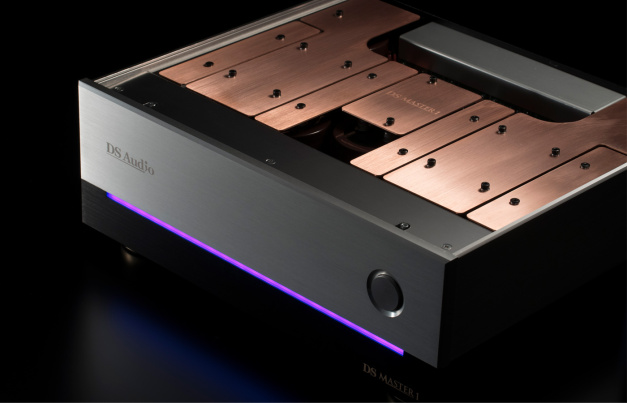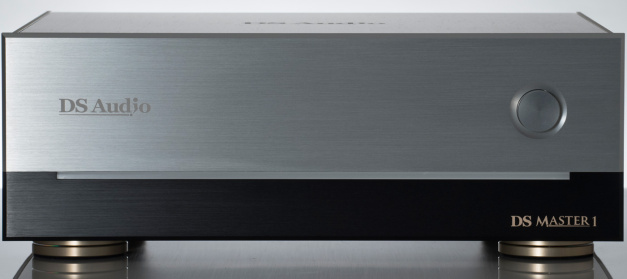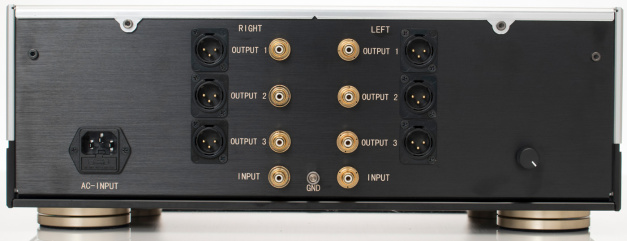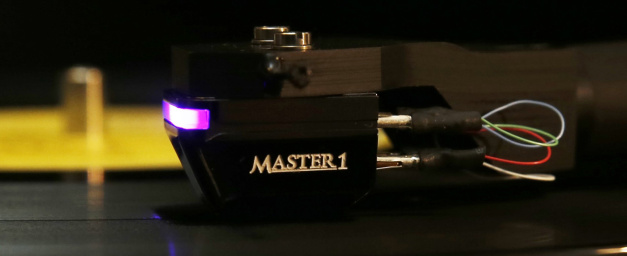Back in April of 2016, I reviewed the DS Audio DS-W1 Optical Phono Cartridge and its matching preamp/equalizer. The DS-W1 preamp/equalizer I reviewed was the first to have built-in RIAA equalization. This cartridge and preamp, when used from the RIAA output, has been in my reference system ever since that review. If you are interested in optical cartridges, it would probably be worth your while to go back and read part one of that review, which deals with the technical side of optical cartridges.
One thing I didn’t mention in that review was that DS Audio is very honest in calling their phono stage a preamp/equalizer. The truth is every phono stage is exactly that — a preamp and an equalizer. Because all modern LPs are equalized to the RIAA curve when they are cut, the job of a phono stage is to match that curve as closely as possible to increase the signal. So don’t be thrown off by the word equalizer, it’s just an honest name.
I know there were a couple of things with the DS-W1 that concerned a few listeners. The first was the bass, which could be a little overpowering through output one and not quite right through the subsonic output. I can promise you that by changing the subsonic output to the RIAA equalization curve, DS Audio has fixed the bass issue in the DS-W1.
The second complaint by a few was that the DS-W1 does not have as big a soundstage as the very best moving coils. As I talked about in my review of the DS-W1, I was able to get a most satisfying soundstage with a little tweaking of the ART Tuning Cones in my room. I should admit what most audiophiles mean by soundstage is not that important to me. It’s great if you can have it, but there are other things that are more important to me. One of the major design goals of the DS Master1 was to increase the channel separation to get a more room-filling soundstage. I can tell you that the DS Master1 totally succeeds with this.

About the DS Master1
Ever since I heard about the DS Master1, I have been trying to get my hands on one. Starting in 2017, DS Audio has three optical cartridges and three preamp/equalizers that all work with each other. This makes it possible to move up in the line in steps or to find the combination that is right for your ears and your pocketbook. A little birdie tells me that there will most likely be a trade-in path to help owners to move up in the line.
The DS Master1 Optical Phono Cartridge is the flagship of the DS Audio line and has some significant changes from the DS-W1. The DS Master1 positions the newly designed micro-optic sensor unit closer to the stylus, resulting in a shorter optical signal path. It also uses a new wire-suspended cantilever. These changes create significant improvements in channel separation.
DS Audio also changed the shape of the stylus and the material used for the cantilever. The DS Master1 uses a micro-ridge stylus that has a minimum curvature radius and is mounted on a sapphire cantilever. The body of the cartridge is made of what they call “Ultra” duralumin to ensure the highest possible rigidity. I should mention that the change from a Shibata stylus on the DS-W1 to a micro-ridge stylus makes it even more critical to get the geometry and VTA right. It took me a little while to get the VTA just right, but it was well worth the time.
The biggest visual change is with the DS Master1 Preamp/Equalizer. To start with, it’s about four times the size of the DS-W1 and weighs in at 53 pounds. That heavy weight comes from the twelve 120K of electrolytic capacitors and three transformers used in the DS Master1 phono stage. To achieve the lowest possible impedance, a pure copper bus-bar provides the connection for the bank of capacitors.
The DS Master1 uses fully discrete dual-mono circuitry with three dedicated power supplies. Each channel has a dedicated power supply to deliver more than ample power, and the third power supply is dedicated to the cartridge LED drive system for the DS Master1 phono cartridge. The DS Master1 features both single-ended RCA inputs and balanced XLR inputs. There are three sets of single-ended RCA and three sets of balanced XLR outputs as well as three separate low-frequency cut-off points:
- Output 1 is “DS Standard” single cut-off with 6db/octave at 30Hz.
- Output 2 is “RIAA Standard” double cut-off with 6db/octave 50.5Hz and 6db/octave at 30Hz.
- Output 3 is “RIAA Sub-sonic” triple cut-off with 6db/octave 50.5Hz, 6db/octave at 30Hz, and 12db/octave at 25Hz. Each low-frequency contour is accessed by its own dedicated single-ended RCA or balanced XLR output for a total of six sets of dual-mono outputs.
A Note About Break-In
When I received the DS Master1 Cartridge and preamp/equalizer for review, I knew the preamp/equalizer was a demo that had been used at shows and for dealer demonstrations. I assumed that the cartridge was as well. So, I didn’t assume there was any need for break-in and just let it warm up. It turned out that I was wrong. The cartridge was brand new. The result was that for the first day or two I thought the DSMaster1 was incredible but lacking in the kind of big tones I so desire. After around 40 hours of playing this turned out not to be true. The DS Master1 has rich, beautiful tonality and the best musical flow I have heard in my room. I am sharing this to encourage anyone who gets this setup to give it time to break in. I don’t know how long the preamp takes to break in since it already had many hours on it when I got it.
Listening to the DS Master1 Optical Phono Cartridge and Preamp/Equalizer
I used my reference system for review. My system consists of my AMG V12 turntable with their 12-inch Turbo tonearm placed on an HRS M3X-1921-AMG isolation platform made for the V12. The power amp for the review was my Pass Labs XA 30.8, and the speakers were my Teresonic Ingenium XR Silvers. All interconnects; speaker and power cables were High Fidelity Cables CT-1 Ultimate Reference Cables. Power conditioning was from the HB Cable Design PowerSlave Marble.
To be honest, I wasn’t prepared for the sound of this phono playback system. I mean, after spending three years listening to the incredible Soundsmith SG-220 Strain Gauge and then the last eleven months with the DS-W1 Optical, I thought I had a handle on what a vinyl playback system was capable of. Not only was I surprised, but I also must admit it’s going to be hard to adequately describe what the DS Master1 cartridge and phono preamp did for my system. It was an experience of an incredibly clear window on live recordings that I have only heard from Strain Gauge or optical cartridges. The sound of the DS Audio’s optical cartridges is so quiet, so clear, so smooth and so lacks the blurring of vibrating magnets that it sounds more like a tape recording than what we have come to think of from vinyl. The DS Master1 system combines this sound with the huge soundstage of the very best and most expensive moving coil cartridges. It’s kind of like having a speaker with the power and clarity of big horns plus the soundstaging abilities of the best monitors and the natural-sounding detail of a great electrostatic. It also has an incredibly silky purity to the high-end that is just beautiful, and it extends the bass with both power and air. The overall sound lets you forget the system and focus more on the performance you are listening to.
The first LP I listened to with this setup was Joan Baez’s live album From Every Stage. On “Swing Low, Sweet Chariot” the sound was unbelievably alive and open with a holographic, three-dimensional soundstage. It had incredible spatial information and an ease about it that made it sound as if I was at the concert listening to Joan Baez. Her voice seemed much more real; this was something to do with the combination of transparency, air and the way the DS Master1 portrays spatial information. On side four of the album, Joan performs “Amazing Grace” as a sing-along. The sound from the stage and crowd was unbelievably huge. When you combine this with the clarity and natural way it sounds, it really makes you feel like you’re at the concert. I bet you won’t be able to keep from joining in the singing.
Then I played Rob Wasserman’s Duets, one of my favorite albums. I love to hear the standup bass played well, and Wasserman’s bass playing is superb. My two favorite cuts are Wasserman’s and Jennifer Warnes’ version of “Ballad of the Runaway Horse” and his duet with Stéphane Grappelli of “Over the Rainbow.” On both songs, the bass was deep, quick and very musical with nice air around and within the instrument. Warnes’ voice has never sounded better on my system, and Grappelli’s playing of the violin was simply incredible and made me want to applaud at the end of the song.
Next, I played some show tunes. It didn’t matter whether it was Cabaret, Chicago, Evita, or Les Misérable, the stage was alive and very three-dimensional. With this kind of music, your enjoyment is certainly enhanced by a well-done soundstage and the ability to hear the crowd at the venue. None of these LPs are in any way audiophile recordings, but after listening to them, I felt like I had been to a great show on Broadway or in San Francisco. By the way, isn’t that what it’s all about?
I listened to one Ellington recording after another. I had never heard my system play big bands like this before. The ability to get really loud without strain and for the brass to have real bite and yet never sound overly shrill was amazing. The combination of dynamics, spatial cues, and tonal correctness was so much fun to listen to. The depth of tones added to the beauty of his band’s performances.
I listened to the entire Bill Evans box set, and consistently from one LP to another heard the kind of big tone you need to truly enjoy great jazz. The kind of air and detail you need for a great piano performance was so moving, as were the micro-dynamics that can make a system sound more like a piano. The interplay between the instruments was easy to hear, and the emotions were easy to feel.
I love the emotions of live recordings, and the DS Master1 brings these out. There’s also something about the ability to hear the audience that adds to the emotional experience. The ability to carry the pace, rhythm and timing so well leads to that emotional experience and makes music one of the real joys of my life.

I could go on and on, but my last example comes from the Mercury Living Presence LP, HI-FI A LA ESPANOLA. I have listened to this album since my college days. The dynamics, which range from an almost silent pianissimo to thundering crescendos, are incredible, and I have never experienced them like I did with this setup. I could hear and feel the full power of the orchestra like never before, and the sound of the bowed basses was an emotional experience. The orchestra floated in a three-dimensional space around and between the speakers that totally disappeared. When the performance reached its climax, each instrument maintained perfect clarity and definition. It was the best I had ever heard this LP sound on any system.
There are a few other areas I must mention where this vinyl playback system enables my system to perform better than ever before. Let’s start with being able to hear layers upon layers of texture. I can’t overstate how this cartridge lets you hear so many layers of tones and music. With the DS Master1, the texture of bowed strings and the speed, attack and decay of plucked strings is also breathtaking when playing an LP of a great performance. It also makes it so easy to follow the interplay between jazz musicians or voices in an a capella ensemble. I could even hear the differences in the textures and harmonics of Sinatra’s voice on a song he sang as a young man versus the same song when he is older. The ability to hear these layers brings new depth into the emotions of the music.
The DS Master1 is by far the most detailed phono playback system I have heard in my system. I hesitate to say this because of the negative connotation that this statement might have in some quarters. I’m using “detailed” here to refer to how easily you can hear the timbre of each instrument, the air around and within the instruments and the tones and phrasing of the human voice. Even with this detail, however, the sound was neither razor sharp nor a bright spotlight on every little thing. It’s like more music just flows fluidly out of the system into my room.
I don’t mean that I hear things on LPs that I’ve never heard before, but I do hear what’s on an LP more easily and with more timbre, pitch and intensity. The subtle changes in a singer’s voice come to life with breath and immediacy. I also heard the nuances of the instruments, the attack of the leading edge and the timbre of the instrument after the leading edge.
Now, let’s talk about the “WOW” factor — the dynamics and palpability are simply incredible! The sound is so dynamic that the music literally explodes out of the speakers, and with the right recordings, it fills a room with a three-dimensional sound. It can go from completely quiet to full tilt in an instant, and it achieves this range in such a completely effortless manner that you don’t think about what a great performance you are hearing or how dynamic it is. Speaking of completely quiet, I think part of what makes optical cartridges sound so explosive is how quiet they are. I have never heard a source that produces as quiet a background as the DS Master1 cartridge and phono preamp.
The bass is a big part of the “WOW” factor. I had no idea my Teresonics could go this deep. One of the things I love about my Teresonics is that they don’t add an extra bass resonance where there isn’t any. This is equally true of the DS Master1. The result is a bass that can explode into the room, rumble into it or even breathe into the room in a way that can catch you off guard.
In my review of the DS-W1, I talked about how exceptional the cartridge is when it comes to temporal realism. This is also true for the DS Master1. Temporal realism is one of the things that most sets live music apart from recorded music. The timing and flow of music seldom seem correct for music played on an audio system. It seems to me that tape and phono cartridges that are displacement-reading devices are better at this than phono cartridges that use magnets. I’m guessing that the movement of the coils or the magnets simply blurs the timing to some small extent. Moving iron cartridges do this less than moving magnets or moving coils, but none that I have heard can match the DS Audio optical cartridges or the Soundsmith Strain Gauge. I have no idea what messes up the temporal realism on digital playback, but it is one of the format’s real weaknesses, in my opinion. The ability to come so much closer to getting the timing and flow of a musical performance correct is part of what makes the DS optical cartridges so enjoyable to listen to.
I also want to point out how the DS Master1 handles space. As my regular readers know, I don’t make the typical audiophile soundstage a high priority. Instead, I want to hear a coherent, whole soundstage. One of the things that I really enjoyed about this cartridge was its ability to give me the best of both worlds. My system played music that not only reproduced the width, depth and height of the soundstage, it also was able to consistently reproduce a coherent soundstage full of air, space, ambiance and energy. One of my pet peeves is for instruments and bodies to sound as if they are floating in empty space. I did not experience this with the DS Master1. Instead, it consistently produced the widest, deepest, tallest and most lifelike scale I have heard from my system.

There’s one final area where the DS Master1 Optical Cartridge is the best I’ve ever heard. It doesn’t emphasize groove noise, pops and ticks. This probably has to do with the shape of the stylus that somehow allows it to get below the noisy and worn parts of the record groove. Whatever it is that eliminates these annoying sounds, this is a great quality in a phono cartridge.
Listening to the DS Master1 Optical Cartridge with the DS-W1 Preamp/Equalizer
For a couple of reasons, I couldn’t wait to hear this combination. First, this is the configuration I would most likely be able to afford, and second, this is a natural step up for the owner of the DS-W1. I’m going to try to tell you how this combination compares to both the DS-W1 system and the DS Master1 system.
Let’s start with the soundstage; this combo is much wider and taller with than the DS-W1. I would go so far as to say that it played the biggest soundstage I had ever heard in my system before I put in the complete DS Master1 system. On the final cut of my live recording of Les Mis, the entire cast enters from stage left and right and joins the main characters to stretch clear across the stage. I heard the sound begin in the far left and right corners of my room and come forward until it stretched wall to wall. Without a doubt, reworking the cartridge achieved DS Audio’s goal of increasing the size of the soundstage by increasing the channel separation.
Using the DS Master1 cartridge with the DS-W1 phono preamp also extended the frequency extremes. The top-end has more sparkle, and the overall sound from the midrange up was very silky. The bottom end was deep, full and powerful. Both the Duets and Moonlight Serenade albums show this on several cuts. I had never heard Ray Brown’s standup bass play so low and with such air and space. Likewise, Laurindo Almeida’s guitar was quicker and had more sparkle than I had heard before. This top-end sparkle was also very apparent on the Alison Krauss Live LP. The bluegrass instruments really showed this off along with the silkiness of Krauss’ voice. As good as this combo sounds, however, the bass and top-end are definitely better with the complete DS Master1 combo.
The DS Master1 cartridge with the DS-W1 preamp is also more transparent and quicker than the DS-W1 system. This transparency opens a very clear window on the sound. There is a beautiful touch of velvet smoothness to the sound, and if this is a coloration, it is surely a beautiful one. I don’t really know how to describe this sound. It is nowhere near being overly smooth and the transients are extremely quick and detailed. Both the macro- and micro-dynamics are simply incredible; so do not take my statement about velvet smoothness to imply slow or boring, as nothing could be less true. It simply enables voices and instruments to sound very beautiful on my system.
The total DS Master1 system is even more transparent and quicker without giving up any of the beauty I have described. Maybe the biggest difference in the total DS Master1 system and the DS Master1/DS-W1 combo are an increase in power that enables you to hear so much more of everything.
Conclusion
I won’t go on and on comparing these three combinations. It’s pretty simple, the complete DS Master1 system is the best that I have ever heard, the combo of the DS Master1 cartridge and the DS-W1 preamp is the second best, and the total DS-W1 is the third-place winner. To round out the five best phono cartridges I have ever heard in my system, fourth place would go to the Soundsmith Strain Gauge, and fifth place would go to the Miyabi Standard moving coil with the Shindo Giscours preamp. The area where the DS Audio cartridges are better than the Strain Gauge is their ability to deliver beautiful, rich tones and wonderful harmonics. The place where the optical and Strain Gauge cartridges are better than the Miyabi Standard and Shindo combo is their lack of smear that comes from the magnets moving. I would like to say that I could live happily with any of the DS Audio Optical Cartridge Systems I have heard. I am dying to hear their new entry-level optical cartridge system.
So, let me conclude with two thoughts. The first thought is how great my system sounded with the DS Master1 as its source. I have never heard so much music flow so easily into my room as I did with the DS Master1. The sound is big, bold and oh so alive. I had a couple of visitors ask if Mike from Teresonic had heard this system because they didn’t know there was a Lowther-based system that could play music like this. I’ll invite Mike over the next time he is up this way.
The second thought can best be described by first telling you that I’m a big college basketball and professional baseball fan. Nothing ruins a game more than when the umpires or referees become noticeable. If they do their job right, you seldom even notice that they are there. The same is true of a great audio system. It’s about experiencing the sounds and feelings of the music in a way that lets you overcome the electronic listening experience. The DS Master1 brought my system closer to that goal than ever before. Nuf’ said!
Cartridge Specifications:
Output Voltage: 500mV
Stylus shape: Micro-ridge
Weight: 8.1g
Tracking: 1.6 – 1.8g (1.7g recommended)
Warranty: 1 Year
Preamp/Equalizer Specifications:
Weight: 24kg
Dimensions (mm): 436W × 161H × 395D
Input Terminal: Single-ended RCA
Output Terminal: Single-ended RCA x3, Balanced XLR x3
Warranty: 1 Year
Price for both: $22,500
U.S. Distributor: Musical Surroundings


